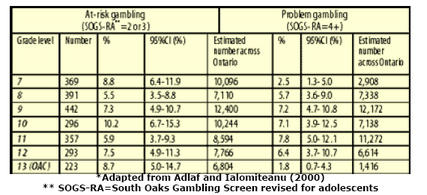Adolescents display higher rates of gambling disorders compared to adults (Shaffer, Hall, & Vanderbilt, 1999). Research suggests these higher rates exist not only because gambling disorders often originate during adolescence (Gupta & Derevensky, 1998; Shaffer & Hall, 1996; Wynne Resources Ltd., 1996), but also because today’s adolescent generation is the first to be socialized into a culture of legalized gambling. This shift in social setting might stimulate higher rates of problem gambling among adolescents (Shaffer et al., 1999). Results derived from a sample taken from the 1999 Ontario Student Drug Use Survey (OSDUS) offer support for these ideas.
Selecting a random sub-sample (n=2371) from the 1999 cycle of the OSDUS, Adlaf and Ialomiteanu (2000) used the 12-item SOGS-RA to determine prevalence and at-risk gambling behavior of adolescents (Mean age=15) over a twelve-month period. SOGS-RA scores of 0-1 indicated no gambling problems, scores of 2-3 demonstrated at-risk gambling, and scores of 4 or more represented problem and pathological gambling (Adlaf & Ialomiteanu, 2000).
Adlaf and Ialomiteanu (2000) found that 13.3% of the Ontario students they surveyed scored 2 or more on the SOGS-RA, with 7.5% meeting the criteria for at-risk gambling and 5.8% meeting criteria for problem gambling. Gambling disorders among the sample population were significantly different by sex: male respondents were more likely than female respondents to report both at-risk and problem gambling (11.4% vs. 3.5%; c2=52.42, df=1,100, P<.001) (Adlaf & Ialomiteanu, 2000). Moreover, Table 1 shows that grade level is significantly related to problem gambling (c2=2.35 df=5,535, P<.036), as respondents in grades 7 and 13 reported lower rates of problem gambling than respondents in other grade levels (Adlaf & Ialomiteanu, 2000).
Table 1. Past year prevalence of at-risk and problem gambling by grade level* 
This research is a valuable contribution to the literature on disordered gambling despite some methodological concerns. Adlaf & Ialomiteanu (2000) admittedly rely solely on data from the SOGS-RA. The accuracy of this self-report measurement is difficult to determine, even if confirmatory clinical assessments were included in the research design-which they were not. Additionally, Adlaf & Ialomiteanu (2000) fail to provide continuous data. As a result, their classification scheme (i.e., at-risk, problem, pathological) is arbitrary in that it does not consider some precise differences between levels of gambling disorders. Nevertheless, the research of Adlaf & Ialomiteanu (2000) should be appreciated not only for the insight it offers on adolescent gambling disorders in Canada, but also for the foundation it lays for future research on adolescent gambling disorders in countries world-wide.
References
Adlaf, E. M., & Ialomiteanu, A. (2000). Prevalence of problem gambling in adolescents: findings from the 1999 Ontario Student Drug Survey. Canadian Journal of Psychiatry, 45, 752-755.
Gupta, R., & Derevensky, J. L. (1998). Adolescent gambling behavior: a prevalence study and examination of the correlates associated with problem gambling. Journal of Gambling Studies, 14, 319-345.
Shaffer, H. J., & Hall, M. N. (1996). Estimating the prevalence of adolescent gambling disorders: a quantitative synthesis and guide toward standard gambling nomenclature. Journal of Gambling Studies, 12, 193-214.
Shaffer, H. J., Hall, M. N., & Vander Bilt, J. (1999). Estimating the Prevalence of Disordered Gambling Behavior in the United States and Canada: A Research Synthesis. American Journal of Public Health, 89, 1369-1376.
Wayne Resources Ltd. (1996). Adolescent gambling and problem gambling in Alberta. Edmonton (AB): Alberta Alcohol and Drug Abuse Commission.




